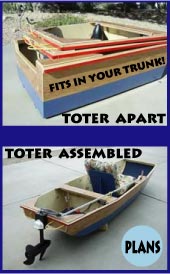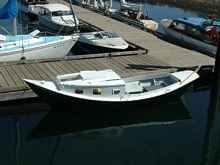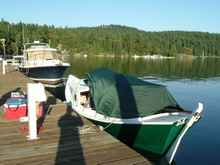
 Custom Search
|
|
| sails |
| plans |
| epoxy |
| rope/line |
| hardware |
| canoe/Kayak |
| sailmaking |
| materials |
| models |
| media |
| tools |
| gear |
 |
 |
| join |
| home |
| indexes |
| classifieds |
| calendar |
| archives |
| about |
| links |
| Join Duckworks Get free newsletter Comment on articles CLICK HERE |
|
|
| Building and Cruising in a St. Pierre Dory - Pt 1 |
by Tom Hruby
- Olympia, Washington - USA |
Part 1 – The First Dory, (I am now building my third one).With the price of gas over $4/gallon now and commercially build cruising boats cost more than $1500/ft, how can we afford to spend time on the water? Those of you reading this article will know that building your own boat is one way to reduce the costs. But... did you know that you can build a 26’ cruising boat that sleeps four for under $10,000 (including the trailer) and costs just 5 cents/mile for power? Or for an extra $2000 you can power it by the sun! The secret is to be willing to cruise quietly and slowly using electric power. Yes, I know you can always use the wind, and I have done my share of sailing and building sailboats. However, here in the Puget Sound area the winds are fluky during the summer and too strong in the winter. Also as I get older I find trailerable sailboats not very comfortable.
So... here is my story. Sixteen years ago I built my first electric St. Pierre Dory, and now I am building my third one. All have been powered by golf cart batteries but my systems have changed as time progressed. I hope you will find my journey of discovery useful. Although I was motivated by exploring different technologies the ultimate goal was to provide comfortable and safe cruising vacations for my family. For many years I have built canoes and small boats but when I got married and kids came along we needed something bigger. So 16 years ago I was looking for something simple to build but large enough to handle my wife and two active kids. I settled on the St. Pierre Dory as the safest small cruising boat. For over 100 years these seaworthy craft have been carrying their crews of two or three fishermen to the fishing grounds off Newfoundland with incredible reliability, safety, and economy. John Gardner in his Dory Book states that not one St. Pierre Dory has ever been lost at sea. That sounded perfect for a young father. I have always been a fan on Phil Bolger and have built two of his boats. But, he did not have any plans for a large dory, so I bought mine from Glen-L Marine. I liked their idea of having a prop shaft that could be lifted out or having an outboard in a well since I wanted to trailer the boat. The thought of keeping a boat in the water all the time, painting the bottom every year, paying for dock space, and here in the Puget Sound area, bailing the rainwater out boat out every week during the winter did not appeal to me. When the eagerly awaited plans finally arrived I carefully studied all the designs and instructions. I hit my first snag which however turned out to be a real “plus.” Dories, especially the big ones like the St. Pierre, need a lot of ballast if you don’t want to bounce around like a cork. I began searching for inexpensive ballast options and found that the cheapest was 50lb boxes of nails that cost $0.50/lb (in 1995). However, I also discovered that golf cart batteries were costing about $1/lb. Bingo! The proverbial light bulb went off. Why not use electric power and have the batteries be the ballast? What I needed was more information. St. Pierre dories used for fishing early in the 20th century were powered by 1.5 – 3 hp Acadia engines (very simple; you start them by turning the flywheel and you stopped it by shorting the plug). This was enough to get them to hull speed. Since 1 hp is equal to 750 watts I figured a 1500 watt motor would be adequate. So I settled on a 36 volt system because that is what they use in golf carts, and motors and parts were easily available. For my first attempt at building a larger boat, I decided to reduce all the dimensions by 10%. At that time I did not feel comfortable trailering a boat that was 8 ft wide (the maximum at that time). Since Glen-L provides full sized patterns for all the ribs, stem and transom, it was relatively easy to reduce the dimensions by 10%. The hardest part was adjusting for the fact that the standard lumber sizes would not be reduced as well. I have only a few photos of this first boat since I did not have a digital camera at that time. The photos I am including are scans of regular prints. When I start writing about boats #2 and #3 I will have many more pictures. As I started building the hull I was looking for an electric motor. Luckily, I found a 2hp permanent magnet motor that used 36 volt DC current. This meant 6 golf cart batteries. The next problem was matching the rpms of the motor to a prop. These large dories like big props with low revolutions. The St. Pierre’s used a 20” prop revolving at around 400 rpm. Ouch!! A 20” prop was around a $1000 at that time. Finally I compromised and found a used 16” prop with a 16” pitch for about $300. I figured I would get hull speed at about 600 rpm with this prop. This meant I needed to reduce the speed of the motor (3600 rpm) to 600. My initial choice was to use a V-belt rated for 4 hp (more on this later). Since I had never used a boat powered by electricity before I decided to play it safe and add a little 8ph air cooled Honda motor. I was using a V-belt so it was easy to rig the gas motor next to the electric one and transfer the belts as needed. There is enough room in the dory to put the two side by side.
When I decided to reduce the size of the boat I also found that installing a box in which to lift the prop would take up too much internal space. I decided to install a fixed shaft “through-hull” and protect the prop on the outside with skegs made out angle iron. This way I could still put the boat on a trailer. I also decided that I would use 3/8 inch plywood covered with polyester resin and 10oz cloth. The inside of the hull however I sealed with epoxy (Gluv-it). Finally the big day arrived and I starting building the boat. My garage was 28 ft long so I thought I could “easily” build it in there. The 24ft of boat should not be problem. The hull is built upside down on a frame. This was the easy part. When the hull was finished I put the frame on casters and rolled it outside. The tricky part was flipping over. I had to build a cradle that surrounded the hull and then used car jacks to slowly turn it over. A crane would have been easier but renting one was a problem. Once the hull was flipped, I raised it off the ground and put the trailer under it and moved it back into the garage to build the cabin and the insides.
Did you know that the inside of a dory makes a wonderful playpen for small kids? When it was my turn to babysit our 18 month old daughter I would put her inside the hull with a box of crayons. This was one place she could color on the “walls” without angering her parents. So, our first dory has the inside of its hull covered in “art work.” I eventually glued Styrofoam on the hull between the ribs for floatation, and the artwork was covered but it did provide many hours of entertainment. My older daughter who at time was 5 also had to participate but she used markers (couldn’t let little sister have all the fun!). I don’t think there was a blank piece of plywood without markings anywhere inside the hull.
After 14 months the boat was finally finished. The big day arrived and I was ready to roll the boat out of the garage. Uh,Oh.... The cabin was about 3” higher than the garage door; something I had not thought about. After a few expletives I finally came up with a solution that did not require de-constructing my house. I took the wheels off the trailer and managed to roll the boat out with the trailer running only on the hubs. So,... after all the necessary rituals were done, the boat was launched and ready for its trial run. The good news – the boat floated and did not leak; the bad news – one V-belt did not work. It slipped a great deal even though it was rated for 4 hp. The small pulley on the motor side needed to give me a 6:1 reduction did not have enough friction to power the belt. Back to the drawing board... My next brainstorm was to use a drive chain like they use in go-carts. That worked fine for about 3 years but then I got tired of the noise, so I replaced the chain with a hydraulic motor and pump. That lasted only two trips. It turned out the hydraulic fluid overheated and I would have had to install a cooler that took up too much space. Oh, well.... Finally, I decided to try two V-belts. I did not know that was possible until I saw a photograph of a 20 hp motor powering a machine and using 5 belts. Finally, I had found something that actually worked and met my needs. The photo above shows the double belts and the electric and gas motors side by side. So, every summer we took the boat out for a week long cruise in Puget Sound. The 6 golf-cart batteries gave us about 2.5 – 3 hrs of cruising time before they ran down. This proved to be adequate because we could tie up at marinas overnight and recharge from the shore power. With small kids our cruising time was limited to about 2 hrs anyway. A vacation is supposed to be fun for everyone so we tried to cruise a little bit and then find distractions on shore. That is not difficult in the Puget Region, especially since we have some very good guidebooks. This photo is of the boat tied up at a marine in Poulsbo.
When cruising the two girls slept in the cabin while my wife and I slept on a temporary platform over the engine compartment. I build a tent like structure over the cockpit to protect us from the elements and passers-by. The photo below shows us re-charging the batteries after a day’s cruise.
We would travel to some location such as Tacoma, or the old Navy station at Sand Point, or Anacortes and launch the boat there to begin a cruise in that area. Cruising in this boat brought us back to the old ways of doing things. We had to watch the tides carefully and plan so we were always traveling with the tide. With tidal currents as high as 8 knots in some parts of the sound we would get nowhere in a boat that has a hull speed of 5 knots unless we planned ahead. After 8 years of summers spent on the water my girls began to complain that the cabin was getting to be too small. Not only were they getting bigger but they insisted on bringing more stuff along – knitting, painting kits, books, etc. So in 2005 I decided it was time to build the full size version of the Lucky Pierre. I still had the plans and could use them again. I will write about the second and third boats in part 2, and how I am going “solar”. |
 |





